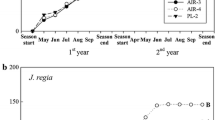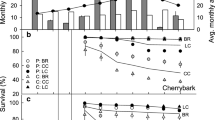Abstract
Root characteristics and field performance of container and bare-root seedlings of red oak (Quercus rubra L.) were compared during the first growing season after planting. Sixty seedlings of each stock type were planted on a clearfell and weed-free site near Restoule, Ontario. Twenty-four additional seedlings from each stock type were compared at the start of the study in terms of shoot and root parameters. Measurement of root and shoot parameters were repeated at three dates during the first growing season in the field. The root systems of container stock had a larger number of first order lateral long roots and were significantly more fibrous than bare-root stock. These differences were sustained throughout the first growing season. In terms of field performance, container seedlings had 100% survival and achieved significant increases in both biomass and shoot extension. Bare-root seedlings suffered 25% mortality, significant shoot dieback and more variable growth. The mean relative growth rate (RGR) of container seedlings increased throughout the study period to a maximum of 30 mg/g/day, whereas the mean RGR of bare-root stock remained close to or below zero. Overall, the container seedlings proved less prone to transplanting shock than the bare-root seedlings, most likely due to favourable root architecture and the pattern of root development. Further work may be warranted in container design, growing regimes and root architecture to fully realise the potential of container systems for the production of high quality red oak seedlings across a range of site conditions.




Similar content being viewed by others
References
Allen SE (1989) Chemical analysis of ecological materials, 2nd edn. Blackwell Scientific Publications, Oxford 368 pp
Anderson HW, Batchelor BD, Corbett CM, Corlett AS, Deugo DT, Husk CF, Wilson WR (1990) A silvicultural guide for the tolerant hardwoods working group in Ontario. Science and Technology Series, vol 7. Ontario Ministry of Natural Resources, Forest Resources Group, Sault Ste. Marie, Ontario, Toronto, 178 pp
Brisette JC, Barnett JP, Landis TD (1991) Container seedlings. In: Duryea ML, Dougherty PM (eds) Forest regeneration manual. Kluwer Academic Publishers, Dordrecht, pp 117–141
Burdett AN (1990) Physiological processes in plantation establishment and the development of specifications for forest planting stock. Can J For Res 20:415–427
Carpenter IW, Guard AT (1954) Anatomy and morphology of the seedling roots of four species of the genus Quercus. J For 52(4):269–274
Davis AS, Jacobs DF (2005) Quantifying root system quality of nursery seedlings and relationship to outplanting performance. New Forests 30(2/3):295–311
Dey DC, Parker WC (1997) Morphological indicators of stock quality and field performance of red oak (Quercus rubra L.) seedlings underplanted in a central Ontario shelterwood. New Forests 14(2):145–156
Dominguez-Lerena S, Herrero Sierra N, Carrasco Manzano I, Ocaña Bueno L, Peñuelas Rubira JL, Mexal JG (2006) Container characteristics influence Pinus pinea seedling development in the nursery and field. For Ecol Man 221:63–71
Fort C, Fauveau ML, Muller F, Label P, Grainier A, Dreyer E (1997) Stomatal conductance, growth and root signalling in young oak seedlings subjected to partial soil drying. Tree Physiol 17:281–289
Garriou D, Girard S, Guehl JM, Généré B (2000) Effect of desiccation during cold storage on planting stock quality and field performance in forest species. Ann For Sci 57:101–111
Girard S, Clément A, Boulet-Gercourt B, Guehl JM (1997) Effects of exposure to air on planting stress in red oak seedlings. Ann Sci For 54(4):395–401
Grossnickle SC (2005) The importance of root growth in overcoming planting stress. New Forests 30(2/3):273–294
Hanson PJ, Dixon RK, Dickson RE (1987) Effect of container size and shape on the growth of northern red oak seedlings. HortScience 22:1293–1295
Harris RW, Dais WB, Stice NW, Long D (1971) Root pruning improves nursery tree quality. J Amer Soc Hort Sci 96(1):105–108
Hatchell GE, Muse HD (1990) Nursery cultural practices and morphological attributes of longleaf pine bare-root stock as indicators of early field performance. Research Paper SE-277. USDA Forest Service, Asheville, NC, 34 pp
Hunt R, Causton DR, Shipley B, Askew AP (2002) A modern tool for classical plant growth analysis. Ann Bot 90:485–488
Jacobs DF (2003) Nursery production of hardwood seedlings. Extension Report FNR-212. Hardwood Tree Improvement and Regeneration Center, Purdue University, Indiana, 8 pp
Jacobs DF, Salifu KF, Seifert JR (2005) Growth and nutritional response of hardwood seedlings to controlled-release fertilization at outplanting. For Ecol Man 214(1–3):28–39
Johnson F, Paterson J, Leeder G, Mansfield C, Pinto F, Watson S (1996) Artificial regeneration of Ontario's forests: species and stock selection manual. Forest Research Information Paper 131. Ontario Ministry of Natural Resources, Ontario Forest Research Institute, Sault Ste. Marie, Ontario, 58 pp
Johnson PS (1979) Growth potential and field performance of planted oaks. In: Holt HA, Fisher BC (eds) Proceedings: Regenerating oaks in upland hardwood forests. The 1979 John S Wright Forestry Conference. Purdue University, Indianna, pp 113–119
Krasowski MJ (2003) Root system modifications by nursery culture reflect on post-planting growth and development of coniferous seedlings. For Chron 79(5):882–891
Lindström A, Rune G (1999) Root deformation in plantations of container-grown Scots pine trees: effects on root growth, tree stability and stem straightness. Plant Soil 217(1–2):29–37
Ontario Ministry of Natural Resources (OMNR) (2000) A silvicultural guide to managing southern Ontario forests, version 1.1. Ontario Ministry of Natural Resources. Queens Printer for Ontario, Toronto, 648 pp
Ontario Ministry of Natural Resource (OMNR) (2001) A review of current and potential seedling production in Ontario for afforestation. Ontario Ministry of Natural Resources, Toronto, 32 pp
Riedacker A, Belgrand M (1983) Morphogénèse des système racinaires des semis et boutures de chêne pédoncule. Plant Soil 71:131–146
Ritchie GA, Dunlap JR (1980) Root growth potential: its development and expression in forest tree seedlings. N Z J For Res 10:218–248
Ruehle JL, Kormanik PP (1986) Lateral root morphology: a potential indicator of seedling quality in northern red oak. Southeasten Forest Experiment Station. USDA Forest Service. Research Note SE-344. 6 pp
Schultz RC, Thompson JR (1997) Effect of density control and undercutting on root morphology of 1 + 0 bareroot hardwood seedlings: five-year field performance of root-graded stock in the central USA. New Forests 13(1–3):301–314
Stroempl G (1985) Grading northern red oak planting stock. Tree Plant Notes 36(1):15–18
Struve DK, Joly RJ (1992) Transplanted red oak seedlings mediate transplant shock by reducing leaf surface area and altering carbon allocation. Can J For Res 22:1441–1448
Thompson JR, Schultz RC (1995) Root system morphology of Quercus rubra L. planting stock and 3-year field performance in Iowa. New Forests 9:225–236
Tinus RW (1979) Use of container-grown hardwoods for reforestation. In: Holt HA, Fisher BC (eds) Proceedings: Regenerating oaks in upland hardwood forests. The 1979 John S Wright Forestry Conference. Purdue University, Indianna, pp 120–125
Wargo PM (1976) Variation of starch content among and within roots of red and white oak trees. For Sci 22:468–471
Wilson BC, Jacobs DF (2006) Quality assessment of temperate zone hardwood seedlings. New Forests 31:417–433
Yemm EW, Willis AJ (1954) The estimation of carbohydrates in plant extracts by anthrone. Biochem J 57:508
Zaczek JJ, Steiner KC, Bowersox TW (1997) Northern red oak planting stock: 6-year results. New Forests 13(1–3):177–191
Acknowledgements
We would like to thank Don Willis (Jiffy Products), Terry Blake, Vera Borsos-Matovina and John McCarron (University of Toronto), and Eva Casson-du Mont (University of Central Lancashire) for technical assistance and contributions to the research. The Ontario Industrial Research Assistance Program and the Ontario Forest Renewal Co-op provided funding and technical support for the project. The Royal Society, London provided funds for completion and presentation of this paper. We thank Doug Jacobs (Purdue University), Andrée Morneault (Ontario Ministry of Natural Resources) and two anonymous reviewers for their constructive comments on earlier versions of the manuscript.
Author information
Authors and Affiliations
Corresponding author
Rights and permissions
About this article
Cite this article
Wilson, E.R., Vitols, K.C. & Park, A. Root characteristics and growth potential of container and bare-root seedlings of red oak (Quercus rubra L.) in Ontario, Canada. New Forests 34, 163–176 (2007). https://doi.org/10.1007/s11056-007-9046-7
Received:
Accepted:
Published:
Issue Date:
DOI: https://doi.org/10.1007/s11056-007-9046-7




